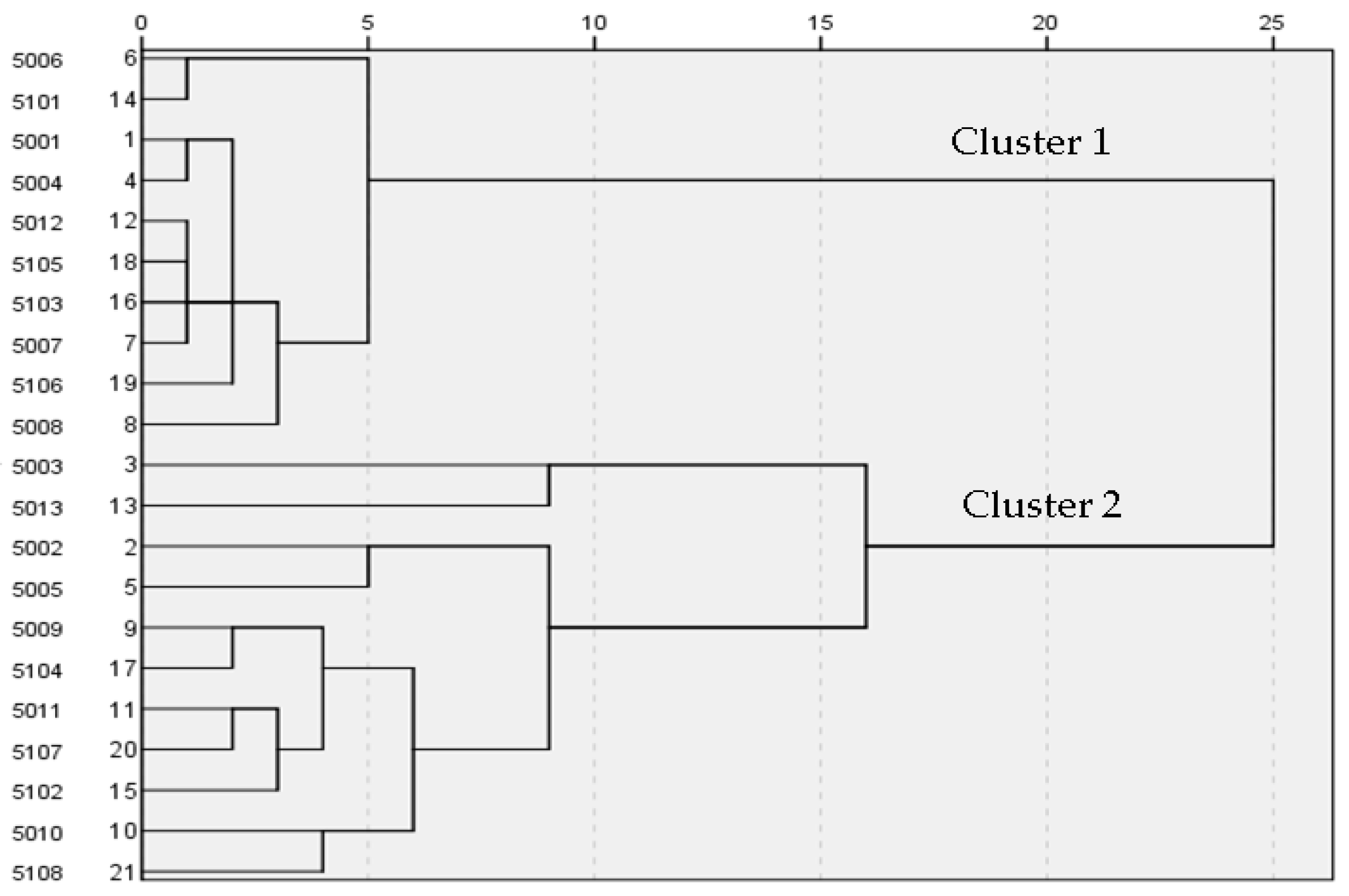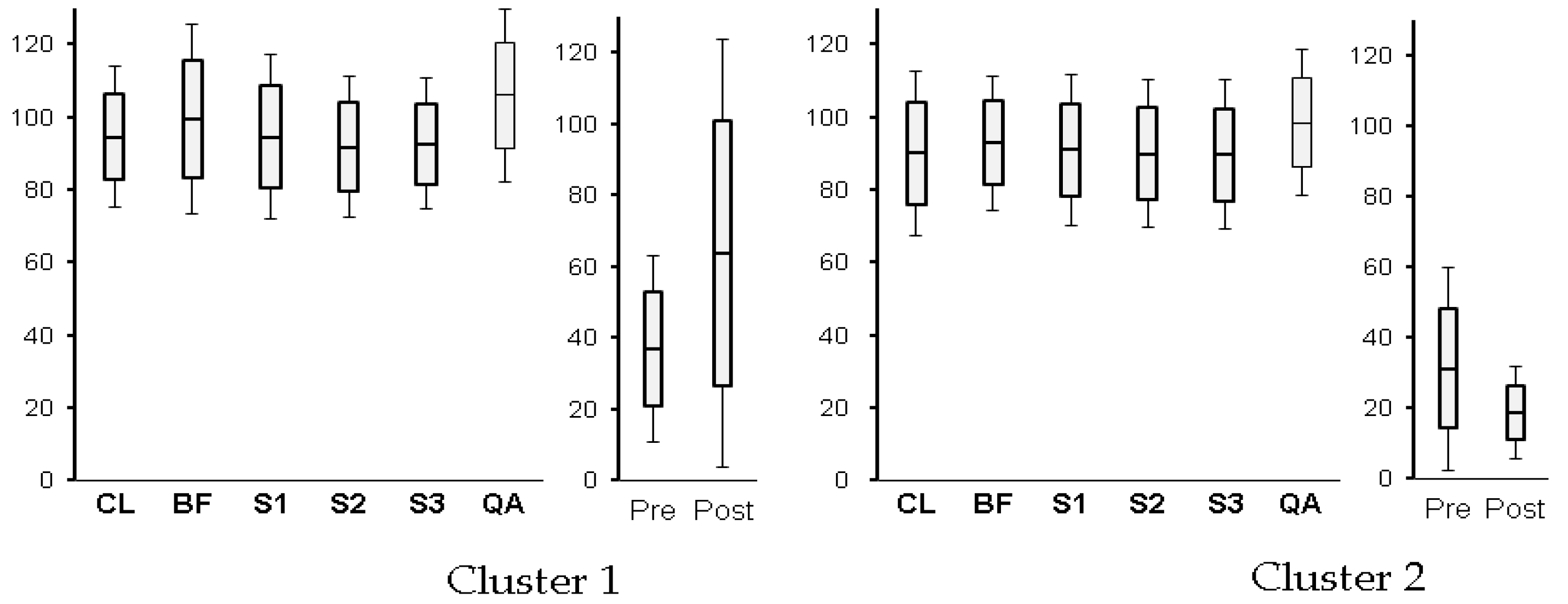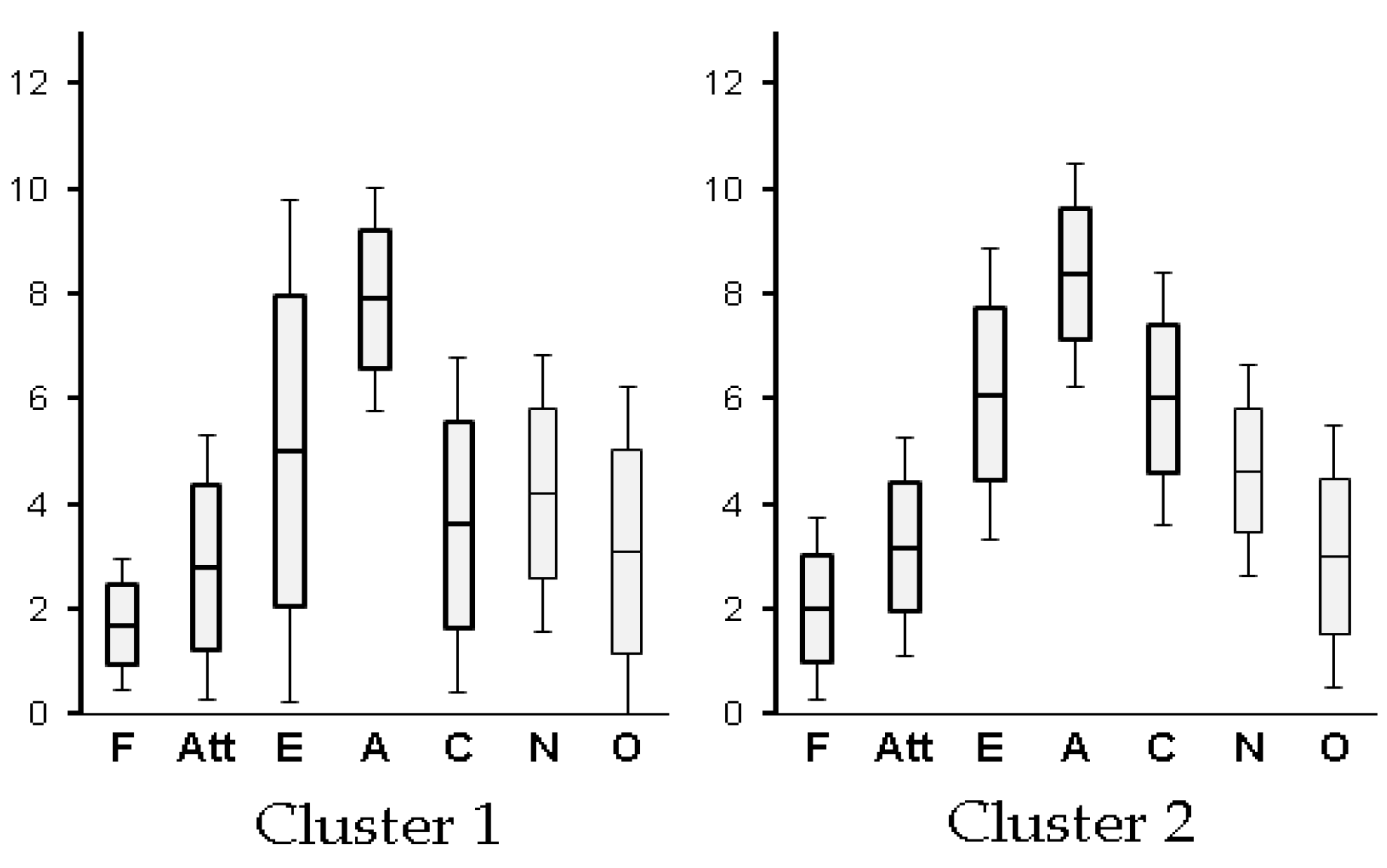Classification of Participants Based on Increase–Decrease Rate Model of Reaction Time to Personality Trait Words
Abstract
1. Introduction
2. Materials and Methods
2.1. Participants
2.2. Experimental Period
2.3. Informed Consent to the Participants
2.4. Equipment
2.5. Personality Inventory and Experiment Stimulus
2.6. Procedure
2.7. Data Analysis
2.8. Ethical Considerations
3. Results
3.1. Cluster Analysis
3.2. Cluster Classified Reaction Time by Personality Trait Term
3.3. Clustered Physiological Index
3.4. Clustered Psychological Index
4. Discussion
5. Conclusions
Author Contributions
Funding
Acknowledgments
Conflicts of Interest
References
- Piéron, H.; Leplat, J.; Chocholle, R. Sensation et Motricité; Presses universitaires de France: Paris, France, 1963. [Google Scholar]
- Oyama, T. Historical background and the present status of reaction time studies. Jpn. J. Hum. Factors 1985, 21, 57–64. [Google Scholar]
- Jensen, A.R. The importance of intraindividual variation in reaction time. Personal. Individ. Differ. 1992, 13, 869–881. [Google Scholar] [CrossRef]
- Rabbitt, P.; Osman, P.; Moore, B.; Stollery, B. There are stable individual differences in performance variability, both from moment to moment and from day to day. Q. J. Exp. Psychol. Sect. A 2001, 54, 981–1003. [Google Scholar] [CrossRef] [PubMed]
- Sato, E.; Matsuda, K. Variance Trend in Reaction Time for Personality Traits; Personality Traits of Version and Emotional Stability. Jpn. J. Appl. Psychol. 2012, 38, 92–100. [Google Scholar]
- Sato, E.; Matsuda, K. The Feature of the Reaction Time for Performing Personality Self-rating: Conditions by Personality Trait Terms and by Sentence. Jpn. J. Appl. Psychol. 2016, 42, 8–15. [Google Scholar]
- Murakami, Y.; Murakami, C. Handbook of Scale Construction of a “Big Five” Personality Inventory—Basis of Personality Measurement and “Big Five” Personality, Revised ed.; Gakyujyutu Tosyo: Tokyo, Japan, 2008; pp. 150–165. [Google Scholar]
- Takahashi, Y.; Yamagata, S.; Kijima, N.; Shigemasu, K.; Ono, Y.; Ando, J. Continuity and Change in Behavioral Inhibition and Activation Systems: A Longitudinal Behavioral Genetic Study. Personal. Individ. Differ. 2007, 43, 1616–1625. [Google Scholar] [CrossRef]
- Tangney, J.P.; Baumeister, R.F.; Boone, A.L. High self-control predicts good adjustment, less pathology, better grades, and interpersonal success. J. Personal. 2004, 72, 271–324. [Google Scholar] [CrossRef] [PubMed]
- Gibbon, J.; Rutschmann, R. Temporal order judgment and reaction time. Science 1969, 165, 413–415. [Google Scholar] [CrossRef] [PubMed]
- Sato, E.; Matsuda, K. A pilot study of change in cerebral activity during personality rating by questionnaire and personal computer. Int. J. Psychol. 2018. [Google Scholar] [CrossRef] [PubMed]
- Ebstein, R.P. The molecular genetic architecture of human personality: Beyond self-report questionnaires. Mol. Psychiatry 2006, 11, 427. [Google Scholar] [CrossRef] [PubMed]
- Keng, S.L.; Lee, Y.; Drabu, S.; Hong, R.Y.; Chee, C.Y.I.; Ho, C.S.H.; Ho, R.C.M. Construct Validity of the McLean Screening Instrument for Borderline Personality Disorder in Two Singaporean Samples. J. Personal. Disord. 2019, 33, 450–469. [Google Scholar] [CrossRef] [PubMed]
- Lai, C.Y.; Ho, C.S.; Lim, C.R.; Ho, R.C. Functional near-infrared spectroscopy in psychiatry. BJPsych Adv. 2017, 23, 324–330. [Google Scholar] [CrossRef]
- Ho, C.S.; Zhang, M.W.; Ho, R. Optical Topography in psychiatry: A Chip Off the Old Block or a new Look Beyond the Mind–Brain Frontiers? Front. Psychiatry 2016, 7, 74. [Google Scholar] [CrossRef] [PubMed]




| Trait Factor | Stimulus Terms/Variable Names | ||||
|---|---|---|---|---|---|
| Big Five Factors | Extroversion | active | sociable | passive | restrained |
| Agreeableness | kindly | affable | headstrong | tightwad | |
| Conscientiousness | capable | conscientious | sloppy | unreliable | |
| Neuroticism | easygoing | sedate | irascibleness | worrier | |
| Openness to experience | intelligent | clever | conservative | naïveté | |
| Practice Stimulus Terms | sincere | amenable | philosophical | - | |
| Session | HEG Conditions | Contents |
|---|---|---|
| Closed-eyes condition | CL | Eyes closed for 3 min as a rest time |
| Questionnaire condition | BF | Self-rating with Big Five inventory before computer session |
| Amylase 1 | Pre | Degree of stress before computer session |
| Computer condition | S1 | Session 1: Simple response to trait words session |
| S2 | Session 2: Personality self-rating by term session | |
| S3 | Session 3: Personality self-rating by sentence session | |
| Questionnaire answering condition | QA | Self-rating with questionnaire after computer session |
| Amylase 2 | Post | Degree of stress after all sessions |
| Trait Words | Cluster 1 | Cluster 2 | ||||||||||
|---|---|---|---|---|---|---|---|---|---|---|---|---|
| Simple | Self-rating | sRT | Simple | Self-rating | sRT | |||||||
| mean | sd. | mean | sd. | mean | sd. | mean | sd. | mean | sd. | mean | sd. | |
| Extroversion | ||||||||||||
| active | 515.1 | 107.1 | 761.3 | 157.9 | 0.861 | 0.384 | 574.1 | 99.7 | 1163.0 | 493.0 | 0.900 | 0.477 |
| sociable | 500.2 | 119.5 | 767.1 | 210.4 | 0.604 | 0.283 | 539.5 | 120.1 | 848.9 | 233.2 | 0.658 | 0.466 |
| passive | 512.9 | 130.5 | 996.0 | 420.8 | 0.985 | 0.409 | 566.7 | 134.7 | 1177.0 | 377.7 | 0.740 | 0.494 |
| restrained | 505.6 | 123.8 | 894.2 | 199.4 | 0.742 | 0.316 | 530.6 | 112.6 | 1080.1 | 252.1 | 0.841 | 0.679 |
| Agreeableness | ||||||||||||
| kindly | 541.2 | 104.0 | 851.1 | 227.2 | 0.465 | 0.347 | 583.5 | 115.6 | 840.1 | 127.6 | 1.075 | 1.107 |
| affable | 536.4 | 117.4 | 811.2 | 134.6 | 0.432 | 0.220 | 592.6 | 115.0 | 1053.9 | 368.3 | 0.513 | 0.566 |
| headstrong | 500.9 | 90.4 | 878.3 | 201.4 | 0.862 | 0.699 | 544.8 | 101.5 | 1016.6 | 192.3 | 1.076 | 0.750 |
| tightwad | 535.3 | 124.1 | 908.9 | 251.7 | 0.690 | 0.333 | 580.8 | 111.4 | 1337.0 | 396.8 | 0.884 | 0.446 |
| Conscientiousness | ||||||||||||
| capable | 580.9 | 123.3 | 985.6 | 247.8 | 0.580 | 0.186 | 651.6 | 135.9 | 1076.5 | 207.3 | 0.457 | 0.173 |
| conscientious | 564.7 | 99.6 | 839.4 | 129.4 | 0.546 | 0.257 | 604.4 | 130.8 | 942.9 | 238.8 | 0.867 | 0.707 |
| sloppy | 617.6 | 144.1 | 1073.4 | 336.0 | 0.670 | 0.348 | 667.4 | 115.3 | 990.4 | 252.1 | 0.800 | 0.467 |
| unreliable | 551.5 | 110.8 | 935.6 | 271.8 | 0.708 | 0.344 | 598.2 | 115.7 | 1046.9 | 373.0 | 1.351 | 0.749 |
| Neuroticism | ||||||||||||
| easygoing | 533.7 | 98.5 | 886.4 | 239.2 | 0.691 | 0.477 | 592.8 | 150.9 | 886.9 | 190.7 | 0.556 | 0.364 |
| sedate | 521.5 | 89.7 | 904.1 | 215.0 | 0.759 | 0.550 | 573.1 | 131.2 | 1267.5 | 544.5 | 1.254 | 1.039 |
| irascibleness | 509.5 | 91.8 | 930.9 | 299.0 | 0.737 | 0.451 | 567.3 | 126.6 | 1014.1 | 378.7 | 0.808 | 0.751 |
| worrier | 534.7 | 137.3 | 808.7 | 148.5 | 0.523 | 0.128 | 572.8 | 125.6 | 896.5 | 170.8 | 0.578 | 0.357 |
| Openness to experience | ||||||||||||
| intelligent | 555.2 | 110.9 | 841.1 | 188.6 | 0.602 | 0.362 | 637.8 | 139.2 | 1061.1 | 227.8 | 0.856 | 0.449 |
| clever | 530.7 | 85.7 | 819.1 | 181.2 | 0.545 | 0.285 | 549.4 | 75.3 | 987.3 | 208.1 | 0.758 | 0.532 |
| conservative | 533.4 | 114.4 | 754.0 | 98.4 | 0.435 | 0.173 | 587.3 | 142.0 | 1088.1 | 370.4 | 0.929 | 0.692 |
| naïveté | 503.9 | 83.1 | 889.3 | 270.6 | 0.716 | 0.604 | 582.3 | 116.9 | 977.1 | 216.7 | 0.698 | 0.361 |
© 2019 by the authors. Licensee MDPI, Basel, Switzerland. This article is an open access article distributed under the terms and conditions of the Creative Commons Attribution (CC BY) license (http://creativecommons.org/licenses/by/4.0/).
Share and Cite
Matsuda, K.; Sato, E. Classification of Participants Based on Increase–Decrease Rate Model of Reaction Time to Personality Trait Words. Behav. Sci. 2019, 9, 155. https://doi.org/10.3390/bs9120155
Matsuda K, Sato E. Classification of Participants Based on Increase–Decrease Rate Model of Reaction Time to Personality Trait Words. Behavioral Sciences. 2019; 9(12):155. https://doi.org/10.3390/bs9120155
Chicago/Turabian StyleMatsuda, Kouhei, and Emi Sato. 2019. "Classification of Participants Based on Increase–Decrease Rate Model of Reaction Time to Personality Trait Words" Behavioral Sciences 9, no. 12: 155. https://doi.org/10.3390/bs9120155
APA StyleMatsuda, K., & Sato, E. (2019). Classification of Participants Based on Increase–Decrease Rate Model of Reaction Time to Personality Trait Words. Behavioral Sciences, 9(12), 155. https://doi.org/10.3390/bs9120155





